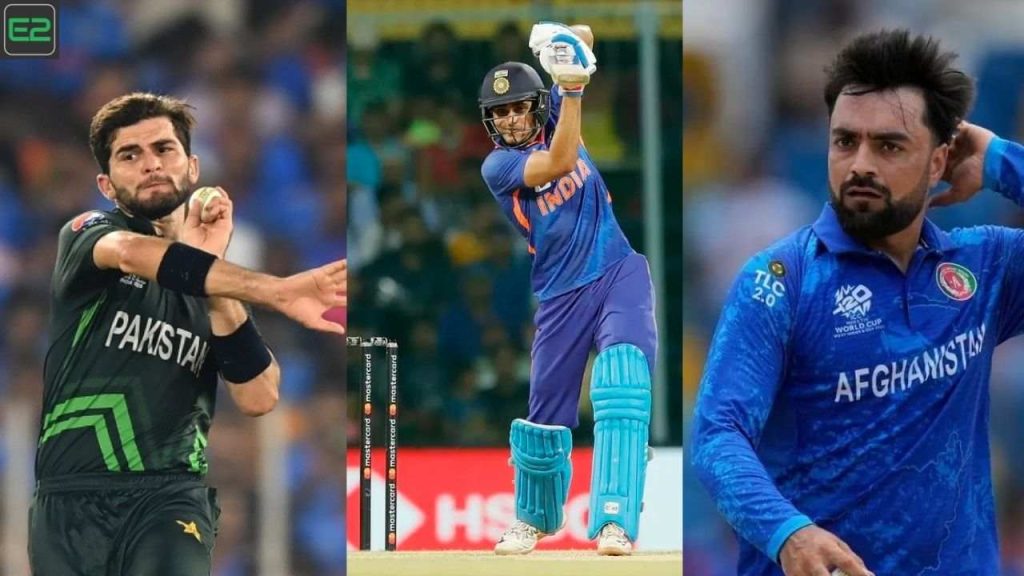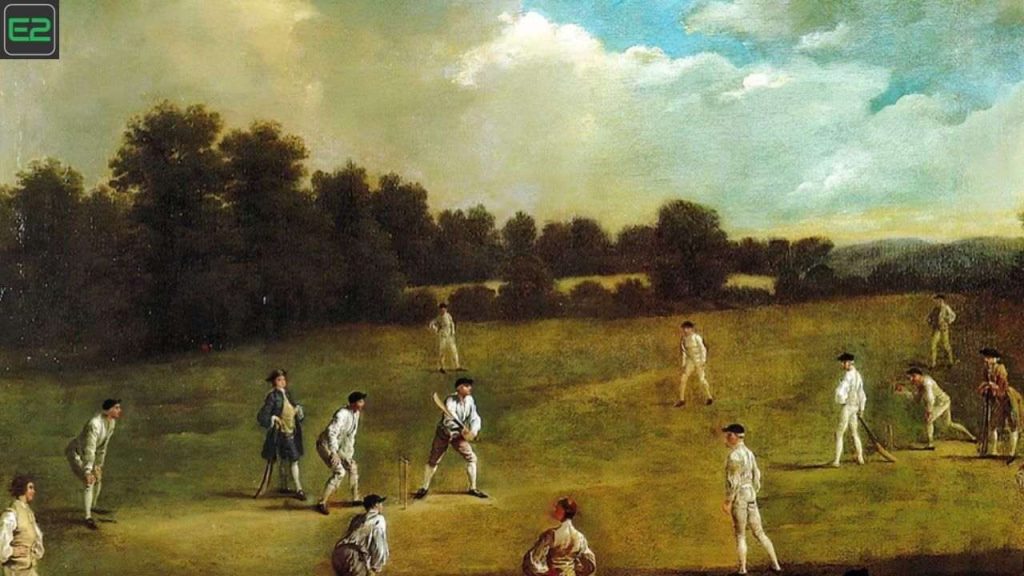Outdoor cricket is played on an oval grass field. In the center, there is a flat strip of ground called the pitch.
Area of pitch: Turf cricket pitch
The dimensions of a turf pitch are 20.12m long (from stump to stump)plus a minimum of 1.22m behind the stumps to accommodate the return crease and bowler approach area. The width of a turf pitch is 3.05m.
The overall dimensions of a turf wicket will vary according to the level of cricket competition being played.

Synthetic pitches
The dimensions of a synthetic cricket pitch range from 25m to 28m long and 2.4m to 2.8m wide. A bowling crease, a popping crease, and two return creases are marked in white at each end of the pitch.
The diagram on the right compares the dimensions of a turf pitch and a synthetic pitch.

The bowling crease
The popping crease
The popping crease is in front of and parallel to the bowling crease. It is 1.22m from the bowling crease is marked to a minimum of 1.83m on either side of the two middle stumps and is unlimited in length.
The return crease
The return crease is at right angles to the popping crease at a distance of 1.32m on either side from the middle of the stumps. The return crease is 2.44m long and is behind the popping crease.
The table below is a summary of the pitch dimensions for the various game formats in all competitions.
| Level of competition | Preferred pitch type and dimensions | |
|---|---|---|
| Minimum | Recommended | |
| In2CRICKET (ages 5-8) | Flexible | To suit ability 13m x 16m x 2.4‑2.8m |
| T20 Blast (ages 8‑12) | Flexible | 18m x 2.4‑2.8m |
| Under 10 | Synthetic | 25‑28m x 2.4‑2.8m |
| Under 12 | Synthetic | 25‑28m x 2.4‑2.8m |
| Under 14 | Synthetic | 25‑28m x 2.4‑2.8m |
| Under 16 | Synthetic | 25‑28m x 2.4‑2.8m |
| Open age (community club) – synthetic only | Synthetic | 25‑28m x 2.4‑2.8m |
| Open age (community club) – turf only | Turf | 25‑28m x 2.4‑2.8m |
| Open age (premier/regional) – turf only | Turf | 22.56m x 3.05m |
| Domestic cricket and underage national events | Turf | 22.56m x 3.05m |
Cricket playing ground
A circular cricket field is considered the perfect field but generally, a cricket pitch is slightly oval. Its diameter varies between 137m and 150m. The ICC Test Match Standard Playing Conditions (October 2014) Law 19.1 defines the playing area as a minimum of 137.16m from boundary to boundary square of the pitch, with the shorter of the two square boundaries a minimum of 59.43m. The straight boundary at both ends of the pitch is a minimum of 64m. Distances are measured from the center of the pitch.
Boundaries are not to exceed 82.29m from the center of the pitch.

Boundary markings
All boundaries are marked by a rope or similar object as per the ICC rules. The rope has a required minimum distance of 2.74m inside the perimeter fencing or advertising signs. For grounds with a large playing area, the maximum length of the boundary should be used before applying the minimum of 3 yards (2.74m) between the boundary and the fence.
When marking a cricket playing field, buffer distances between cricket ground boundaries in relation to other park infrastructure including car parks, roadways, neighboring properties, and playgrounds need to be considered. Buffer distances of between 20m to 40m from boundaries are preferable to reduce risk of damage to park users and property.
Infield, outfield and close-infield
The infield, outfield, and close‑infield are used to enforce field restrictions and/or safety zones for some game formats and age groups.
Two semi‑circles with a radius of 27.43m are drawn in the field of play. The center of these circles is the middle stump at either end of the pitch. The circles are marked by continuous painted white lines or dots at 4.57m intervals, each dot to be covered by a white plastic or rubber disc measuring 18cm in diameter.
Two inner circles with a radius of 13.72m are also drawn on the field of play. The center of the circles is the center point of the popping crease at either end of the pitch. These areas are also marked with dots.
Modified cricket for juniors
There are formats for various age groups catering to skill levels, age groups, levels of commitment,t and other social, cultural, and geographic considerations.
Below is a summary of field dimensions for the various game formats in all competitions.
| Level of competition | Preferred pitch type and dimensions* | |
|---|---|---|
| Minimum | Recommended | |
| In2CRICKET (ages 5-8) | 25m | 30m |
| Under 10 | 30m | 40m |
| Under 12 | 40m | 45m |
| Under 14 | 45m | 50m |
| Under 16 | 45m | 55m |
| Open age (community club) | 50m | 60m |
| Open age (premier/regional) | 65m | 75m |
| Domestic cricket and underage national events | 82m | 82m |
| Domestic women and underage National Girls events | 58m | 58m |
Practice cricket nets
Generally, practice cricket nets are 20m long and 3.6m wide. The back and side walls are 3m high.
With multi‑bay construction, the dividing (center) net must be 21m long. This is an occupational health and safety measure to protect the bowlers in adjacent nets.
Peripheral nets require a minimum side fencing length of 11m. It is recommended that all nets have a minimum 21m dividing fence and are 27m long to allow for extended bowler run‑ups and bowler protection.
Australian Standards
No Australian Standard specific to cricket net design in Australia currently exists. The following standards relate to cricket net materials:
AS1725.4 – 2010: Chain link fabric fencing—Cricket net fencing enclosures.
AS1725.1 – 2010: Chain link fabric fencing—Security fencing and gates—General requirements.
Indoor cricket
The indoor cricket court is a minimum of 28m to a maximum of 30m long and a minimum of 10.5m to a maximum of 12m wide. The height of the facility is 4m to 4.5m. All lines are 55mm wide.
The pitch is the area between both sets of stumps, the bowling return creases, and the offside lines at the striker’s end.
A wicket line is marked in line with the stumps at each end, and is 1.83m wide at the batting end and 2.47m at the bowling end, with the stumps in the centre and the middle stumps 20m apart.
The popping crease is in front of, and parallel with, the wicket lines at both ends. It has its back edge 1.22m center of the stumps. At the striker’s end, it extends from one side of the court to the other and is called the batting crease. At the bowler’s end, it is the line extending between the return creases which is called the bowler’s crease or the front foot line.
The return creases at the bowler’s end are at right angles to the bowling crease to the line of the wickets. The return creases are marked 1.22m from the middle stump on the line of the wicket.
The running crease (or non-striking batter’s crease), which is the edge of the crease marking nearest the bowling end, is parallel to the popping crease and extends from one side of the court to the other.
The distance between the running crease and the batting crease is 11m.
The legside lines are positioned with the inside edge 45 cm from the middle stump. The legside lines extend to a minimum of 15 cm at right angles to the batting crease. The offside or wide lines are positioned with the inside edge 90 cm from the center stump.
A fielding Exclusion Zone is marked in an arc extending from the center of the batting crease at a radius of 3m.
The underarm line is marked across the pitch, 7m from the striker’s stumps.















